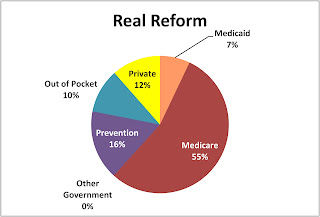 If this is to be our fate in the New Year, then perhaps we can take some comfort in knowing that the debate probably won’t make a dime’s worth of difference about where most of us get our health care over the next few years or how we pay for it.
If this is to be our fate in the New Year, then perhaps we can take some comfort in knowing that the debate probably won’t make a dime’s worth of difference about where most of us get our health care over the next few years or how we pay for it.This is because the 2010 Affordable Care Act and the individual mandate were not really health reform. They were efforts to preserve health insurance as we know it, by getting more people who can afford it to purchase private insurance, and more who cannot onto the Medicaid public insurance program.
So maybe we should take a minute between caucuses, primaries, and the general election to imagine what real health reform in America would look like in 2012.
It isn’t hard. We just have to keep in mind a few facts. First, governments already pay approximately $1.8 trillion of our roughly $2.5 trillion annual national health care bill. Individuals pay another $300 billion out-of-pocket. These numbers aren’t going down, whether the Affordable Care Act is upheld or repealed by the Supreme Court in June.
First, governments already pay approximately $1.8 trillion of our roughly $2.5 trillion annual national health care bill. Individuals pay another $300 billion out-of-pocket. These numbers aren’t going down, whether the Affordable Care Act is upheld or repealed by the Supreme Court in June.Second, there is plenty of money in our health system to delivery high quality health care to everyone who needs it. We just need to target it to prevention as well as treatment.
Third, for the relatively small amount of money they put into the system, insurance companies have been given an outsized role in determining when, where, and how our health care is delivered. Fourth, we woefully underfund our most important health services. Public health and prevention activities have accounted for half of the gains in life expectancy during the last century, but receive far less than 5% of health care funding.
And fifth, we criminalize instead of preventing and treating much of mental illness, and have made jails our nation’s largest mental health institutions.With those facts in mind, we should acknowledge what real health reform isn’t.
It is not Romney’s or Obama’s “individual mandate” to buy private health insurance people don’t want and won’t trust.It is also not Ron Paul’s notion of leaving people to fend for themselves in some non-existent “health care marketplace.” No civilized nation does this and we are not going to be the first.
Here’s what a true American health reform – one that would result in healthier citizens, better access to care when it is needed, lower long term costs of care, and better quality – would look like.1. We would rebuild our health care delivery system around the federalized funding that already dominates health financing. Medicare would be our basic national health insurance program, and be available to everyone.
2. Medicaid would become a federal program like Medicare, and cover only long term care needs including chronic mental illnesses. There would be no means-tested eligibility. States would not have to pay for it or administer it, so they could lower their state taxes accordingly.
3. Private insurers, which are already such a small part of the overall health financing market, would play a role to which they are more suited. They could offer supplemental insurance products covering first-dollar deductibles, co-pays, and additional, discretionary consumer services (like private hospital rooms and gourmet meals) at whatever prices they could get, for whatever profit they could make.
4. The Medicaid program could still require that people spend down a considerable portion of their own resources before it covered the remainder of long term care costs. But we should allow everyone to set up tax-deferred long term care savings accounts to use for themselves, members of their families, or anyone else they designate.
5. We would double the percentage of health dollars in public health and prevention over the next ten years.
How could we finance such as system of care? The reality is that this system probably wouldn’t cost us any more than the current one does, and would probably cost less.Of course, we won’t get this reform, but we can dream. And I’d much prefer such a real policy debate about health reform in 2012 to the one we’re scheduled to receive – Mitt Romney attacking the individual mandate he invented and Barack Obama defending the individual mandate he opposed.
If you have questions about this column or wish to receive an email notifying you when new Our Health Policy Matters columns are published, please email gionfriddopaul@gmail.com.
Related Post:
Widget by [ Iptek-4u ]